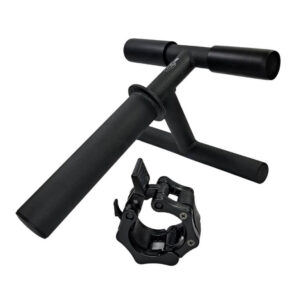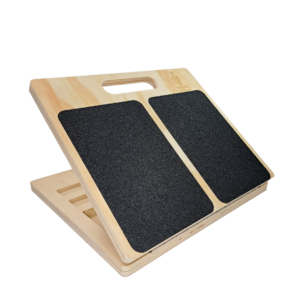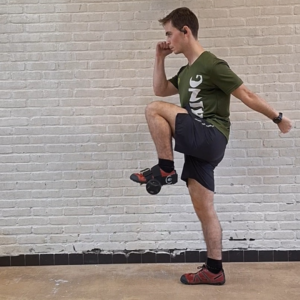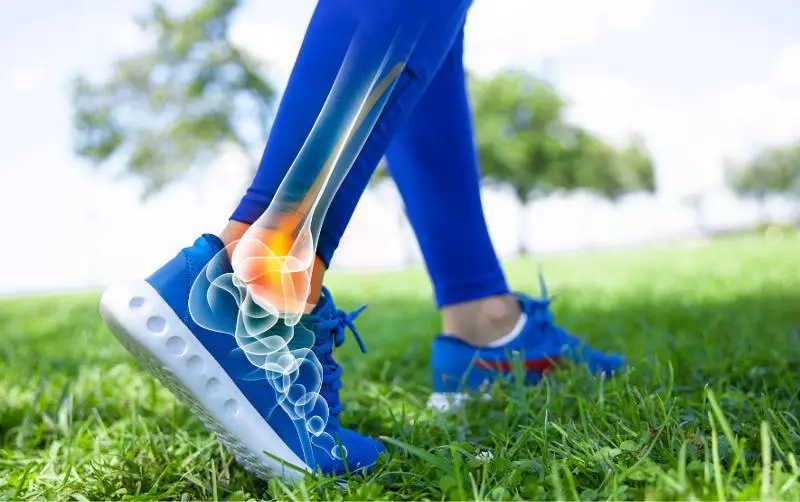
It’s always a good time to talk about ankle exercises. After all, the ankles provide a stable foundation for movement, absorb impact, and transfer force efficiently. By targeting specific muscles and tendons in the ankle region, you can develop stability, power, and flexibility in the whole of your lower body.
Let’s delve into the ankle exercises that can help you achieve these goals.
Table of Contents
THE IMPORTANCE OF ANKLE EXERCISES FOR ATHLETES
Before we dive in, it’s good to establish why ankle strength is so important.
The ankles are involved in virtually every athletic movement, including running, jumping, cutting, pivoting, and landing. That’s why weak or unstable ankles limit your ability to generate power and maintain balance.
By strengthening the ankle muscles and improving flexibility, you can reduce the risk of injuries such as sprains, strains, and tendonitis.
1. FHL CALF RAISE: STRENGTHENING THE ANKLE FOR PERFORMANCE
HOW TO PERFORM FHL CALF RAISES
- Stand with your feet apart (shoulder-width) while keeping your toes pointing forward.
- Shift your weight to your left foot and raise your right foot.
- Engage your calf muscles and lift your body through the ball of your left foot.
- Hold for a moment. Feel the contraction in your calf muscles.
- Lower your body back to the starting position in a controlled manner.
- Repeat the exercise for reps and switch to the other leg.
BENEFITS OF FHL CALF RAISES
The FHL (Flexor Hallucis Longus) Calf Raise targets the calf muscles and the muscles in the arch of the foot.
These play a crucial role in ankle stability and push-off power. By performing this exercise regularly, you can experience the following benefits:
- Increased calf muscle strength:
The FHL Calf Raise specifically targets the calf muscles, building strength and endurance. Strong calves provide a solid foundation for explosive movements. - Enhanced ankle stability:
This exercise activates the muscles in the arch of the foot, which play a crucial role in maintaining ankle stability. Strengthening these muscles can help prevent ankle sprains and other injuries. - Improved balance and proprioception:
Focusing on the toes while performing the exercise builds balance and proprioception.
Feel free to dive deeper into this exercise through our FHL calf raises guide.
2. SOLEUS CALF RAISE: ENHANCING ANKLE STABILITY AND POWER
HOW TO PERFORM SOLEUS CALF RAISE
- Stand with your feet hip-width apart. Keep your toes pointing forward.
- Place a block or step on the floor in front of you.
- Set the balls of your feet on the edge of the block, with your heels hanging off.
- Raise your body by pushing through the balls of your feet.
- Try to lift your heels as high as possible.
- Hold the position for a moment. Feel the contraction in your calf muscles.
- Lower your body back down. Control the movement.
- Repeat for reps.
BENEFITS OF SOLEUS CALF RAISE
The Soleus Calf Raise targets the soleus muscle, a deeper calf muscle responsible for ankle stability and endurance. Incorporating this exercise into your training routine can yield the following benefits:
- Improved ankle stability and strength:
The Soleus Calf Raise specifically targets the soleus muscle, which plays a crucial role in ankle stability. Strengthening this muscle can help athletes maintain proper form and stability during dynamic movements. - Enhanced ankle power:
By focusing on slow and controlled movement, you develop the necessary power in the calf muscles. This enables you to generate explosive force through the ankles. - Reduced risk of Achilles tendon injuries:
Strengthening the soleus muscle can help alleviate stress on the Achilles tendon, reducing the chance of tendonitis or related injuries.
3. TIBIALIS RAISE: BUILDING ANKLE FLEXIBILITY AND PREVENTING INJURIES
HOW TO PERFORM TIBIALIS RAISES
- Sit on a chair or bench, with your feet flat on the ground.
- Place a resistance band around the balls of your feet.
- Pull your toes toward your shins against the resistance of the band.
- Hold the flexed position for a moment. Feel the contraction in the front of your lower leg.
- Slowly return to the starting position.
- Repeat the exercise for reps.
BENEFITS OF TIBIALIS RAISE
The Tibialis Raise targets the tibialis anterior muscle, located at the front of the lower leg. This ankle exercise offers a few significant benefits:
- Increased ankle flexibility: Performing Tibialis Raises helps with stretching and strengthening the muscles on the front of the lower leg. These in turn support the motions of the ankle.
- Balanced muscle development: Developed tibialis anterior muscles ensure balanced muscle development in the lower leg. This results in a reduced risk of muscle imbalances and potential injuries.
- Injury prevention: Strengthening the tibialis anterior muscles helps prevent common injuries such as shin splints and stress fractures.
4. SLANT BOARD CALF STRETCH: INCREASING ANKLE MOBILITY
HOW TO DO THE SLANT BOARD CALF STRETCH
- Place a slant board or another elevated surface at an angle against a wall.
- Stand on the board (while facing it) with one foot on the board and the other on the ground.
- Make sure your toes are pointing straight ahead and that your heel is slightly off the edge.
- Lean forward and allow your body weight to stretch your calves.
- Hold the stretch for 20-30 seconds. Try to catch that comfortable but noticeable tension in your calf.
- Repeat with the opposite leg.
BENEFITS OF THE SLANT BOARD CALF STRETCH
The Slant Board Calf Stretch is an effective exercise for improving ankle mobility and flexibility. Here’s a few benefits to expect if you stay at it:
- Increased ankle range of motion:
The slant board angle allows for a deeper stretch of the calf muscles. This increased range of motion is beneficial for various movements, such as squatting, jumping, and changing directions quickly. - Alleviated tightness and muscle imbalances:
Tight calf muscles can lead to imbalances in the lower leg and foot, predisposing you to injuries. Regularly performing the slant board calf stretch can help alleviate this tightness significantly. - Improved muscle recovery:
Stretching the calf muscles after intense workouts or competitions helps with blood circulation, reducing muscle soreness, and aiding in the recovery process. Incorporating the slant board calf stretch into a post-workout routine can support efficient muscle recovery.
INCORPORATING ANKLE EXERCISES INTO YOUR TRAINING ROUTINE
Now that we have explored some ankle exercises, it’s essential to talk about how to incorporate them into a training routine effectively. Here are some tips for integrating ankle exercises into your training regimen:
Warm-up
Before starting any exercise, warm up your muscles and joints. Perform a dynamic warm-up routine that includes light cardiovascular activity, followed by dynamic stretches for the lower body.
Exercise selection
Choose a combination of ankle exercises that target different muscle groups and aspects of ankle strength and mobility. We’ve talked about more than enough for you to start.
If you’re still not sure how to begin, hop onto our Library Of Knowledge, where we talk about all thinks strength, endurance, and longevity.
FREQUENCY AND SETS
Progression
As you become comfortable with the exercises, it’s time to progress to more challenging variations of ankle exercises. For example, you can hold dumbbells while performing calf raises or use a thicker resistance band for Tibialis Raises.
REST AND RECOVERY
Rest between exercise sessions to promote muscle recovery and prevent overuse injuries. Listen to your body and adjust the frequency and intensity of ankle exercises you do weekly. Additionally, you should look into foam rolling as a recovery option too.
BALANCE WITH OTHER TRAINING COMPONENTS
Ankle exercises should be part of a well-rounded training program that includes strength training, cardiovascular exercises, agility drills, and sports-specific skill practice. Do not overdo it, but don’t skip it either.
COMMON MISTAKES TO AVOID WITH ANKLE EXERCISES
While performing ankle exercises, there are a few things to keep track of. Because we are talking about balance, it’s not uncommon to get sidetracked and do some harm while exercising. So, here are some mistakes to avoid:
- Poor form:
Maintain proper form throughout each exercise to target the intended muscles. This prevents unnecessary strain on other joints. Avoid rounding the back, arching the feet excessively, or using momentum to “get that edge”. - Neglecting both sides:
Ensure you perform ankle exercises on both legs to maintain balance, strength, and stability. Neglecting one side can lead to muscle imbalances and increased injury risk. - Overloading too soon:
Gradually increase the intensity, resistance, or repetitions of the exercises over time. Avoid overloading the ankles too soon, as it can lead to strain or injury. Listen to your body and progress at a pace that feels challenging yet manageable. - Skipping warm-up and cool-down:
Always warm up before starting to prepare the muscles and joints for the workout. Additionally, cool down and stretch after the exercises to aid in muscle recovery. - Neglecting rest and recovery:
Make sure there are enough rest days between ankle exercise sessions to give the muscles time to recover and adapt. Pushing through excessive fatigue or soreness increases the risk of injury.
QUICK TIPS FOR OPTIMAL ANKLE EXERCISE PERFORMANCE
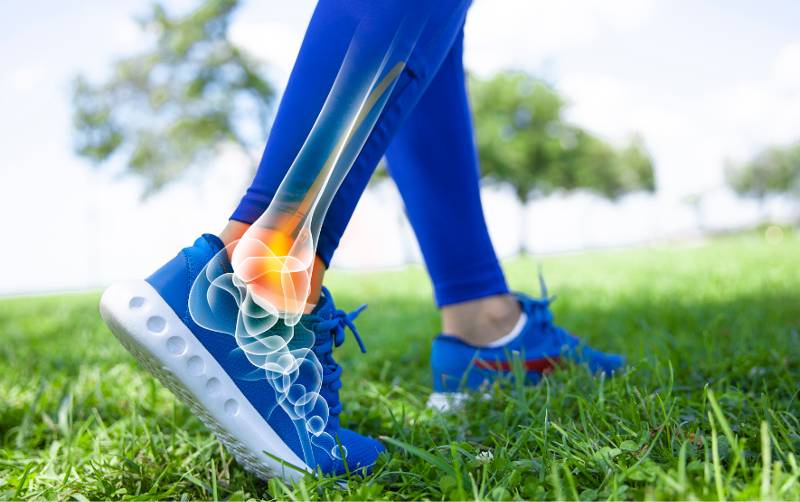
To maximize the benefits of ankle exercises and improve your performance, consider the following tips:
- Engage your core:
Maintain proper posture and engage your core muscles while performing ankle exercises. A strong core helps transfer force efficiently through the lower body. - Focus on the mind-muscle connection:
Concentrate on the targeted muscles during each exercise. Visualize the muscles working and contracting. - Control the movement:
Avoid rushing through the exercises. Focus on slow and controlled movements to fully engage the muscles. - Breathe properly:
Remember to breathe throughout the exercises. Inhale during the initial phase and exhale during the exertion phase of each repetition. - Gradually increase intensity:
As your strength and endurance improve, make sure to increase the intensity of the exercises. This can be done by adding resistance, increasing the range of motion, or incorporating variations. - Listen to your body:
Pay attention to any discomfort or pain during the exercises. If you experience sharp pain or excessive discomfort, stop and consult a healthcare professional. Prioritize safety and avoid pushing through pain. - Stay consistent:
Consistency is critical when it comes to seeing improvements in ankle strength and performance. Make ankle exercises a regular part of your training routine to reap the long-term benefits.
Remember, while ankle exercises can be beneficial for athletes, it’s essential to consult with a qualified trainer or healthcare professional if you have any pre-existing conditions or concerns.
ANKLE EXERCISES – FAQ
HOW OFTEN SHOULD I PERFORM ANKLE EXERCISES?
Aim for two to three times per week for optimal results. Make sure you have sufficient rest days between sessions for muscle recovery.
CAN ANKLE EXERCISES HELP PREVENT ANKLE SPRAINS?
Yes, ankle exercises can and will help strengthen the muscles and ligaments around the ankle, reducing the risk of ankle sprains.
ARE THESE ANKLE EXERCISES SUITABLE FOR ALL ATHLETES?
It’s always important to consider individual fitness levels and any pre-existing ankle conditions. Consult with a healthcare professional for personalized guidance. But if you start slowly and don’t work through the pain, you should progress with no issues. Even as a beginner.
SHOULD I CONSULT A TRAINER BEFORE STARTING ANKLE EXERCISES?
It’s always a good idea to seek guidance from a qualified trainer or healthcare professional, especially if you’re new to ankle exercises. But, in most cases, there’s nothing to be afraid of. These ankle exercises are there to prevent future injuries, after all.
CAN ANKLE EXERCISES IMPROVE MY BALANCE?
Yes, ankle exercises engage the muscles responsible for balance and proprioception, which improves overall balance and stability.
In Conclusion
Incorporating ankle exercises into your training routine is vital if you’re looking to improve your performance. On the other hand, developed ankles will make your everyday activities much easier as well.
So, don’t overlook the importance of ankle exercises. Strengthen your ankles, improve your performance, and reduce the risk of injuries with a solid ankle exercise routine!
Start bulletproofing your body with the best equipment:
GET THE BEST INJURY-PREVENTION TRAINING EQUIPMENT:
Above all, a storyteller. Then comes marketing, branding, writing music, powerlifting, and woodworking.


